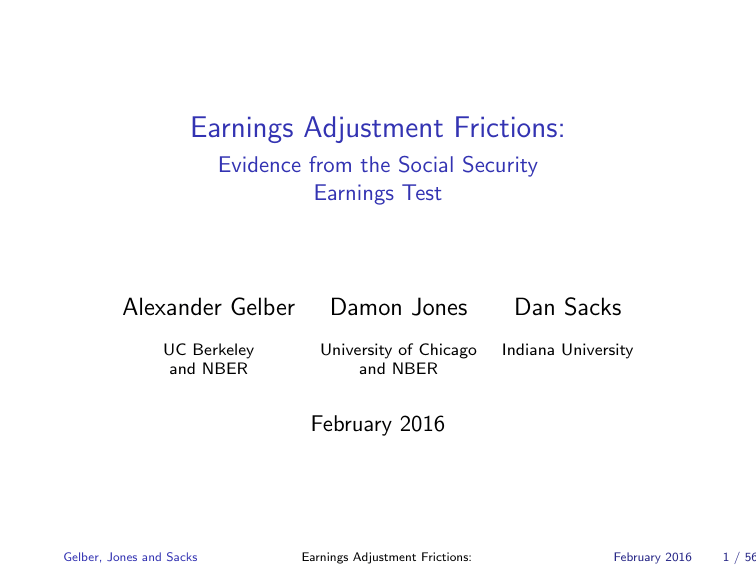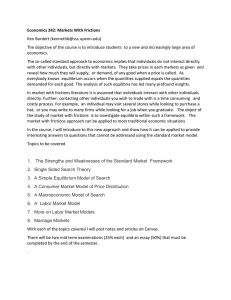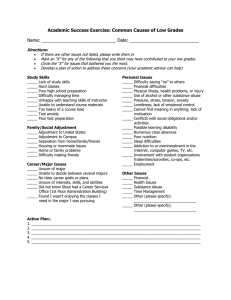Earnings Adjustment Frictions: Alexander Gelber Damon Jones Dan Sacks
advertisement

Earnings Adjustment Frictions:
Evidence from the Social Security
Earnings Test
Alexander Gelber
Damon Jones
Dan Sacks
UC Berkeley
and NBER
University of Chicago
and NBER
Indiana University
February 2016
Gelber, Jones and Sacks
Earnings Adjustment Frictions:
February 2016
1 / 56
Outline
Introduction
Empirical Framework
Social Security Earnings Test
Data
Documenting Adjustment Frictions
Estimating Elasticity and Adjustment Cost
Results
Conclusion
Gelber, Jones and Sacks
Earnings Adjustment Frictions:
February 2016
2 / 56
Introduction
Motivation
I
Social Security Policy Parameter: When to begin payments?
I
I
I
Our project aims to:
I
I
I
Should payments be conditional on earnings while retired?
Behavioral response of earnings is key to designing policy
Document presence of frictions in adjusting earnings in the U.S.
Estimate adjustment cost and earnings elasticity simultaneously using
variation from tax kinks
Methodology for estimating adjustment cost and elasticity applicable
to many other policy contexts
Gelber, Jones and Sacks
Earnings Adjustment Frictions:
February 2016
3 / 56
Introduction
Motivation
I
Recent papers have studied how barriers to adjustment:
I
I
I
Build upon existing literature on fixed costs (e.g. Arrow et al. 1951;
Caplin 1985; Grossman and Laroque 1990)
I
I
I
Drive heterogeneity in elasticity of earnings with respect to taxes across
contexts (Chetty et al. 2011; Chetty 2012; Chetty et al. 2012; Chetty,
Friedman, and Saez 2013)
Govern the welfare implications of taxes (Chetty, Looney, and Kroft
AER 2009)
Estimate fixed cost in the context of earnings determination
Use non-linear budget set kinks created by tax policy for identification
Extend existing bunching methods to:
I
Apply to budget set kinks
I
I
I
Kleven and Waseem (QJE 2013) innovate method to use notch to
estimate elasticity and inert share
We estimate elasticity and adjustment cost
Exploit dynamic changes in bunching across policy regimes & time
Gelber, Jones and Sacks
Earnings Adjustment Frictions:
February 2016
4 / 56
Introduction
Our Context
I
Social Security Annual Earnings Test (AET) reduces OASI benefits
when individuals claim (age 62+) and earn above exempt amount
I
I
I
Creates kinks in budget constraint
Actuarial adjustment/Delayed Retirement Credit: will discuss in detail
Response widely studied (e.g. Burtless and Moffitt 1985; Friedberg
1998, 2000; Song and Manchester 2007)
Gelber, Jones and Sacks
Earnings Adjustment Frictions:
February 2016
5 / 56
Introduction
Our Context
I
AET is particularly fruitful policy to study
I
I
I
Administrative panel data on earnings from Social Security
Administration are accurate and have large sample size
Large changes in AET policy across groups and over time
Hard to find variation in taxes that allows for credible estimation of
elasticities
I
I
I
Kinks in tax schedule helpful (Saez AEJ 2010)
However, little evidence in U.S. of reaction to kinks other than
self-employed, where reaction is largely tax avoidance and evasion
(Chetty, Friedman, and Saez 2013)
AET creates one of few known kinks in U.S. that influences earnings of
non-self-employed (as we show)
Gelber, Jones and Sacks
Earnings Adjustment Frictions:
February 2016
6 / 56
Outline
Introduction
Empirical Framework
Social Security Earnings Test
Data
Documenting Adjustment Frictions
Estimating Elasticity and Adjustment Cost
Results
Conclusion
Gelber, Jones and Sacks
Earnings Adjustment Frictions:
February 2016
7 / 56
Empirical Framework
Basic Framework
I
Individuals ”bunch” (i.e. cluster) at the AET exempt amount
I
Intuition:
I
I
I
I
I
BRR rises (from zero to a positive level) at exempt amount: z ∗
For many people, worth it to earn more at the margin when benefit
reduction rate is zero (below exempt amount) but not at BRR in the
region above the exempt amount
This produces “bunching” in the earnings distribution at the exempt
amount as people cluster near this earnings level
Define B as the share of population bunching, and h0 (z ) as the ex
ante density of earnings
Note: AET is not a tax
I
I
Not administered through tax system
Borrow terminology from tax literature given applicability of methods
for estimating elasticities and adjustment costs more broadly
Gelber, Jones and Sacks
Earnings Adjustment Frictions:
February 2016
8 / 56
Empirical Framework
Characterizing the earnings response
Gelber, Jones and Sacks
Earnings Adjustment Frictions:
February 2016
9 / 56
Empirical Framework
Characterizing the earnings response
Gelber, Jones and Sacks
Earnings Adjustment Frictions:
February 2016
10 / 56
Empirical Framework
Characterizing the earnings response
Gelber, Jones and Sacks
Earnings Adjustment Frictions:
February 2016
11 / 56
Empirical Framework
Characterizing the earnings response
Gelber, Jones and Sacks
Earnings Adjustment Frictions:
February 2016
12 / 56
Empirical Framework
Quantifying the Amount of Bunching
Gelber, Jones and Sacks
Earnings Adjustment Frictions:
February 2016
13 / 56
Empirical Framework
Estimating Adjustment Dynamics
I
We report the amount of bunching, normalized by the density of
earnings at z ∗ , i.e. b = B/h (z ∗ )
I
Approximately the earnings adjustment of the highest earning buncher
(4z ∗ )
I
We estimate excess bunching on repeated cross sections occurring
m = 0, 1, 2... years after change in policy that individuals face
I
We look at how excess bunching varies with m
I
Cleanest evidence from kinks disappearing — there should be no
bunching and we can measure the amount of time it takes for bunching
to disappear
Gelber, Jones and Sacks
Earnings Adjustment Frictions:
February 2016
14 / 56
Outline
Introduction
Empirical Framework
Social Security Earnings Test
Data
Documenting Adjustment Frictions
Estimating Elasticity and Adjustment Cost
Results
Conclusion
Gelber, Jones and Sacks
Earnings Adjustment Frictions:
February 2016
15 / 56
Social Security Earnings Test
Social Security Earnings Test
I
For earnings above threshold, AET reduces current SS benefits
I
Reduction rate and exempt amount vary by age and year
Gelber, Jones and Sacks
Earnings Adjustment Frictions:
February 2016
16 / 56
Social Security Earnings Test
Earnings Test Changes
Gelber, Jones and Sacks
Earnings Adjustment Frictions:
February 2016
17 / 56
Social Security Earnings Test
Social Security Earnings Test Features
I
For claimants under NRA, actuarial adjustment: losing benefits due to
AET causes upward adjustment to reduction factor that affects later
benefits
I
I
I
I
If earn any amount above AET exempt amount, future benefits
increased (relative to earning under exempt amount)
Future benefits increased by 5/9 of percent per month with reduction
due to AET
Delaying claiming actuarially fair for average worker
For those Normal Retirement Age (NRA)+ 1972-2000, DRC: losing
benefits due to AET causes upward adjustment that affects later
benefits
I
Future benefits only raised due to the DRC when earnings are
sufficiently high that the individual receives no OASI benefits in a given
month
Gelber, Jones and Sacks
Earnings Adjustment Frictions:
February 2016
18 / 56
Social Security Earnings Test
Social Security Earnings Test Features
I
Despite actuarial adjustment and DRC, individuals may respond to
AET because:
I
I
I
I
I
Over NRA: AET on average roughly actuarially fair only beginning in
the late 1990s
Expected lifespan short
Liquidity constraints
High discount rate
Not understanding AET or other aspects of OASI rules
I
I
I
Liebman and Luttmer 2011; Brown, Kapteyn, Mitchell, and Mattox
2013
No benefit enhancement if NRA+ and near the exempt amount
Follow approach in most previous literature and do not attempt to
distinguish these reasons
I
Gelber, Jones, and Sacks (2014) investigate certain mechanisms
Gelber, Jones and Sacks
Earnings Adjustment Frictions:
February 2016
19 / 56
Outline
Introduction
Empirical Framework
Social Security Earnings Test
Data
Documenting Adjustment Frictions
Estimating Elasticity and Adjustment Cost
Results
Conclusion
Gelber, Jones and Sacks
Earnings Adjustment Frictions:
February 2016
20 / 56
Data
Social Security Master Earnings File
I
Social Security Administrative Data
I
1% extract of SS claimants
I
Complete earnings history 1951-2006 of calendar year earnings for
each SSN in sample
I
Not manipulable through deductions, credits, etc.
I
Key covariates: earnings, date of birth, when claiming began, SS
benefits
I
Since 1978, ET has been assessed on earnings in each calendar year,
which is the same time frame (i.e. calendar year) as earnings are
observed in our data
Gelber, Jones and Sacks
Earnings Adjustment Frictions:
February 2016
21 / 56
Data
Data
I
Focus on ages 62-69 (but sometimes look at other ages)
I
Individuals who claim by age 65
I
Positive earnings
I
For results by age, look within a policy regime (e.g. 1983-1989,
1990-1999, 2000-2003)
I
Pool men and women
Gelber, Jones and Sacks
Earnings Adjustment Frictions:
February 2016
22 / 56
Data
Summary Statistics, SSA Master File: Mean (SD)
Ages 62-69
Mean Earnings
29,892.63
(783,842.99)
25th Percentile
50th Percentile
75th Percentile
5,887.75
14,555.56
35,073.00
Fraction Male
0.57
Observations
376,431
1% sample, 1978-2005, conditioned on claiming SS benefits by age 65; 2010 dollars
Gelber, Jones and Sacks
Earnings Adjustment Frictions:
February 2016
23 / 56
Outline
Introduction
Empirical Framework
Social Security Earnings Test
Data
Documenting Adjustment Frictions
Estimating Elasticity and Adjustment Cost
Results
Conclusion
Gelber, Jones and Sacks
Earnings Adjustment Frictions:
February 2016
24 / 56
Documenting Adjustment Frictions
Bunching by Age - 59
Gelber, Jones and Sacks
Earnings Adjustment Frictions:
February 2016
25 / 56
Documenting Adjustment Frictions
Bunching by Age - 60
Gelber, Jones and Sacks
Earnings Adjustment Frictions:
February 2016
25 / 56
Documenting Adjustment Frictions
Bunching by Age - 61
Gelber, Jones and Sacks
Earnings Adjustment Frictions:
February 2016
25 / 56
Documenting Adjustment Frictions
Bunching by Age - 62
Gelber, Jones and Sacks
Earnings Adjustment Frictions:
February 2016
25 / 56
Documenting Adjustment Frictions
Bunching by Age - 63
Gelber, Jones and Sacks
Earnings Adjustment Frictions:
February 2016
25 / 56
Documenting Adjustment Frictions
Bunching by Age - 64
Gelber, Jones and Sacks
Earnings Adjustment Frictions:
February 2016
25 / 56
Documenting Adjustment Frictions
Bunching by Age - 65
Gelber, Jones and Sacks
Earnings Adjustment Frictions:
February 2016
25 / 56
Documenting Adjustment Frictions
Bunching by Age - 66
Gelber, Jones and Sacks
Earnings Adjustment Frictions:
February 2016
25 / 56
Documenting Adjustment Frictions
Bunching by Age - 67
Gelber, Jones and Sacks
Earnings Adjustment Frictions:
February 2016
25 / 56
Documenting Adjustment Frictions
Bunching by Age - 68
Gelber, Jones and Sacks
Earnings Adjustment Frictions:
February 2016
25 / 56
Documenting Adjustment Frictions
Bunching by Age - 69
Gelber, Jones and Sacks
Earnings Adjustment Frictions:
February 2016
25 / 56
Documenting Adjustment Frictions
Bunching by Age - 70
Gelber, Jones and Sacks
Earnings Adjustment Frictions:
February 2016
25 / 56
Documenting Adjustment Frictions
Bunching by Age - 71
Gelber, Jones and Sacks
Earnings Adjustment Frictions:
February 2016
25 / 56
Documenting Adjustment Frictions
Bunching by Age - 72
Gelber, Jones and Sacks
Earnings Adjustment Frictions:
February 2016
25 / 56
Documenting Adjustment Frictions
Bunching by Age - 73
Gelber, Jones and Sacks
Earnings Adjustment Frictions:
February 2016
25 / 56
Documenting Adjustment Frictions
Responses by Age (1990-99)
Gelber, Jones and Sacks
Earnings Adjustment Frictions:
February 2016
26 / 56
Documenting Adjustment Frictions
Responses by Age (1990-99)
Gelber, Jones and Sacks
Earnings Adjustment Frictions:
February 2016
27 / 56
Documenting Adjustment Frictions
Summary
I
Substantial bunching from 62-69
I
Continued bunching at 70 and 71
I
No significant evidence of bunching starting at age 72
I
Dip in bunching at age 65 (kink moves)
I
Results are robust to Binsize, degree of polynomial and excluded
I
These changes are anticipated (i.e. an individual who knew about the
parameters of AET law would have anticipated the changes)
Gelber, Jones and Sacks
Earnings Adjustment Frictions:
February 2016
28 / 56
Outline
Introduction
Empirical Framework
Social Security Earnings Test
Data
Documenting Adjustment Frictions
Estimating Elasticity and Adjustment Cost
Results
Conclusion
Gelber, Jones and Sacks
Earnings Adjustment Frictions:
February 2016
29 / 56
Estimating Elasticity and Adjustment Cost
Estimating Elasticity and Adjustment Cost
I
First review results in a frictionless model
I
Next compare two thought experiments in the presence of a fixed
adjustment cost
1. Moving from no kink to a kink
2. Moving from a larger kink to a smaller kink
I
Extend to a dynamic setting
Gelber, Jones and Sacks
Earnings Adjustment Frictions:
February 2016
30 / 56
Estimating Elasticity and Adjustment Cost
Estimating Elasticity and Adjustment Cost
I
Individuals maximize u (c, z; a) s.t. c = (1 − τ ) z + R
I
I
I
I
Saez (2010) model
Earning generates disutility: z
Indexed by ability: a
Individuals must incur a cost of φ in order to change earnings
Gelber, Jones and Sacks
Earnings Adjustment Frictions:
February 2016
31 / 56
Estimating Elasticity and Adjustment Cost
Estimating Elasticity and Adjustment Cost: Frictionless
Gelber, Jones and Sacks
Earnings Adjustment Frictions:
February 2016
32 / 56
Estimating Elasticity and Adjustment Cost
Estimating Elasticity and Adjustment Cost: Frictionless
Gelber, Jones and Sacks
Earnings Adjustment Frictions:
February 2016
33 / 56
Estimating Elasticity and Adjustment Cost
Estimating Elasticity and Adjustment Cost: Frictionless
Gelber, Jones and Sacks
Earnings Adjustment Frictions:
February 2016
34 / 56
Estimating Elasticity and Adjustment Cost
Estimating Elasticity and Adjustment Cost: Cross Section
Gelber, Jones and Sacks
Earnings Adjustment Frictions:
February 2016
35 / 56
Estimating Elasticity and Adjustment Cost
Estimating Elasticity and Adjustment Cost: Cross Section
Gelber, Jones and Sacks
Earnings Adjustment Frictions:
February 2016
36 / 56
Estimating Elasticity and Adjustment Cost
Estimating Elasticity and Adjustment Cost: Cross Section
Gelber, Jones and Sacks
Earnings Adjustment Frictions:
February 2016
37 / 56
Estimating Elasticity and Adjustment Cost
Estimating Elasticity and Adjustment Cost: Cross Section
Gelber, Jones and Sacks
Earnings Adjustment Frictions:
February 2016
38 / 56
Estimating Elasticity and Adjustment Cost
Estimating Elasticity and Adjustment Cost: Kink Variation
I
Now imagine we introduce a larger kink (K1 ) first, and then transition
to a smaller kink (K2 )
I
We will now observe attenuation in the change in bunching, i.e. less
”debunching” than we would expect
I
This leads to ”excess” bunching left over at the kink when moving
from K1 to K2
I
as compared to moving from no kink to K2
Gelber, Jones and Sacks
Earnings Adjustment Frictions:
February 2016
39 / 56
Estimating Elasticity and Adjustment Cost
Estimating Elasticity and Adjustment Cost: Sharp Change
Gelber, Jones and Sacks
Earnings Adjustment Frictions:
February 2016
40 / 56
Estimating Elasticity and Adjustment Cost
Estimating Elasticity and Adjustment Cost: Sharp Change
Gelber, Jones and Sacks
Earnings Adjustment Frictions:
February 2016
41 / 56
Estimating Elasticity and Adjustment Cost
Estimating Elasticity and Adjustment Cost: Sharp Change
Gelber, Jones and Sacks
Earnings Adjustment Frictions:
February 2016
42 / 56
Estimating Elasticity and Adjustment Cost
Estimating Elasticity and Adjustment Cost: Sharp Change
Gelber, Jones and Sacks
Earnings Adjustment Frictions:
February 2016
43 / 56
Estimating Elasticity and Adjustment Cost
Estimating Elasticity and Adjustment Cost: Intuition
I
Two moments (B1 & B̃2 ), two unknowns (ε & φ)
I
I
Inertia due to an adjustment cost leads to an excess amount of
bunching after a kink in the budget set becomes less sharply bent (or
disappears altogether).
I
I
Identification intuitively arises from two sources: the amount of
bunching in a single cross-section, and the change in the amount of
bunching from one cross-section to another (which is attenuated by
adjustment cost)
Our primary estimation method uses the degree of such inertia (in
combination with the initial amount of bunching at the kink) in
estimating the size of the adjustment cost (and elasticity)
Resulting parameters mean that bunching in the time frame studied
can be predicted if individuals faced the estimated adjustment cost
and elasticity
I
I
In the spirit of Friedman (1953)
Study immediate adjustment to a policy change, so parameters pertain
to frictions faced in immediately adjusting
Gelber, Jones and Sacks
Earnings Adjustment Frictions:
February 2016
44 / 56
Estimating Elasticity and Adjustment Cost
Dynamic Extension
I
So far, rely on moments just before and after the policy change
I
Two additional patterns:
I
I
I
Delayed adjustment in subsequent period
Lack of anticipatory response
Extend model to dynamic context
I
I
Stochastic adjustment process that generates slow reaction to policy
change
Assume agents are myopic
Gelber, Jones and Sacks
Earnings Adjustment Frictions:
February 2016
45 / 56
Estimating Elasticity and Adjustment Cost
Dynamic Extension
I
vt = u (ct , zt ; a) − φ̃t · 1 {zt 6= zt −1 }
I
φ̃t = φ > 0 with probability π t −t ∗ , otherwise φ̃t = 0
I
I
τ 0 in period 0, τ 1 until period T1 , τ 2 thereafter
1/ε
u (ct , zt ; a) = c − 1+a1/ε za
I
zt − T (zt ) − ct ≥ m
I
Optimal strategy:
I
I
I
Adjust if 4u > φ̃t
Any ”active” adjustment (i.e. when φ̃t > 0) takes place immediately
Thereafter, only adjust when φ̃t = 0
Gelber, Jones and Sacks
Earnings Adjustment Frictions:
February 2016
46 / 56
Estimating Elasticity and Adjustment Cost
Dynamic Extension
I
For 0 < t ≤ T1 :
B1t
I
t
t
j =1
j =1
= ∏ π j · B1 + 1 − ∏ π j
!
· B1∗
For t > T1 :
B̃2t
t −T1
=
∏ πj ·
j =1
"
T1
B̃2 +
1 − ∏ πj
!
#
[B1∗
− B1 ] + 1 −
j =1
t −T1
∏ πj
As t → ∞, B1t → B1∗ and B̃2t → B2∗
I
Nests frictionless model (π = 0) and static model (π = 1)
Earnings Adjustment Frictions:
· B2∗
j =1
I
Gelber, Jones and Sacks
!
February 2016
47 / 56
Estimating Elasticity and Adjustment Cost
Dynamic Extension
I
Observe bunching around 2+ policy changes
I
I
π’s estimated relative to each other from pattern of bunching over time
Delay in adjustment corresponds to higher π
I
Higher φ means more inertia in all periods until bunching is fully
adjusted
I
Higher ε means more bunching once bunching is fully adjusted
I
Comparative static model transparently illustrates the basic forces
I
Estimation of more dynamic model requires more moments from the
data
I
Assumption that ability fixed over time may be more plausible in static
model when we use two cross-sections from adjacent time periods
I
But dynamic model allows more direct account of forces determining
the time pattern of bunching.
Gelber, Jones and Sacks
Earnings Adjustment Frictions:
February 2016
48 / 56
Estimating Elasticity and Adjustment Cost
Estimating Elasticity and Adjustment Cost: Identification
Gelber, Jones and Sacks
Earnings Adjustment Frictions:
February 2016
49 / 56
Estimating Elasticity and Adjustment Cost
Elasticity Estimates by Year, Saez (2010) Method
Gelber, Jones and Sacks
Earnings Adjustment Frictions:
February 2016
50 / 56
Estimating Elasticity and Adjustment Cost
Estimation
I
Empirically observing bunching amounts B = (B1 , ..., BL )
I
Nonparametrically estimate H0 (·) — and therefore h0 (·) using age
72 earnings
I
Given a value for (ε, φ), z ∗ , T (z ) and H0 we can calculate B̂
I
Finally:
0
ε̂, φ̂ = arg min B̂ (ε, φ) − B W B̂ (ε, φ) − B
ε,φ
I
Similar method for estimation of (ε, φ, π 1 , π 2 , π 3 )
Gelber, Jones and Sacks
Earnings Adjustment Frictions:
February 2016
51 / 56
Outline
Introduction
Empirical Framework
Social Security Earnings Test
Data
Documenting Adjustment Frictions
Estimating Elasticity and Adjustment Cost
Results
Conclusion
Gelber, Jones and Sacks
Earnings Adjustment Frictions:
February 2016
52 / 56
Results
Estimating Elasticity and Adjustment Cost: 1990 Policy
Change
Baseline
Bandwidth = $1,600
Benefit Enhancement
(1)
(2)
ε
φ
0.35
[0.31, 0.43]
0.33
[0.29, 0.43]
0.58
[0.50, 0.72]
$278.25
[57.68, 390.77]
251.45
[33.57, 406.70]
$150.91
[17.31, 225.54]
(3)
(4)
ε|φ = 0
1990
1989
0.58
[0.45, 0.73]
0.55
[0.43, 0.72]
0.87
[0.69, 1.11]
0.31
[0.24, 0.39]
0.30
[0.23, 0.40]
0.52
[0.41, 0.66]
All estimates are significantly different from zero at the 0.01 level.
Gelber, Jones and Sacks
Earnings Adjustment Frictions:
February 2016
53 / 56
Results
Estimating Elasticity and Adjustment Cost: Dynamic
Model
(1)
Baseline
Bandwidth $1.6K
Benefit
Enhancement
(2)
(3)
(4)
(5)
ε
φ
π1
π1 π2
π1 π2 π3
0.36
[0.34, 0.40]
0.36
[0.34, 0.39]
0.59
[0.54, 0.64]
$243.44
[34.07, 671.19]
98.61
[19.48, 400.52]
$52.55
[17.65, 168.52]
0.64
[0.39, 1.00]
0.88
[0.40, 1.00]
1.00
[0.76, 1.00]
0.22
[0.00, 0.14]†
0.52
[0.043, 1.00]
0.37
[0.00, 1.00]
0.00
[0.00, 0.14]†
0.00
[0.00, 0.071]
0.00
[0.00, 0.084]
All estimates are significantly different from zero at the 0.01 level, except for
†
Model Fit
Gelber, Jones and Sacks
Earnings Adjustment Frictions:
February 2016
54 / 56
Outline
Introduction
Empirical Framework
Social Security Earnings Test
Data
Documenting Adjustment Frictions
Estimating Elasticity and Adjustment Cost
Results
Conclusion
Gelber, Jones and Sacks
Earnings Adjustment Frictions:
February 2016
55 / 56
Conclusion
Findings
I
Evidence of earnings adjustment frictions in U.S.
I
Develop method to estimate elasticities and adjustment costs in
presence of kinks in budget set
I
Baseline: Elasticity = 0.35 and adjustment cost = $280
I
I
I
I
Delays in reacting show that the short-run impact of policy can be
substantially attenuated
I
I
Results can be used as an input into calculating score of eliminating
AET
Two of the parameters in a welfare analysis of the AET
If assumed no adjustment cost: elasticity = 0.58
Frustrates goal of immediately affecting earnings as envisioned in many
recent fiscal policy discussions
Methodology for calculating elasticity and adjustment cost more
broadly applicable to many policies
Gelber, Jones and Sacks
Earnings Adjustment Frictions:
February 2016
56 / 56
Conclusion
Simulated Bunching Using Dynamic Model
Gelber, Jones and Sacks
Earnings Adjustment Frictions:
February 2016
56 / 56
Conclusion
Simulated Bunching Using Dynamic Model
Dynamic
Results
Gelber,
Jones and Sacks
Earnings Adjustment Frictions:
February 2016
56 / 56





